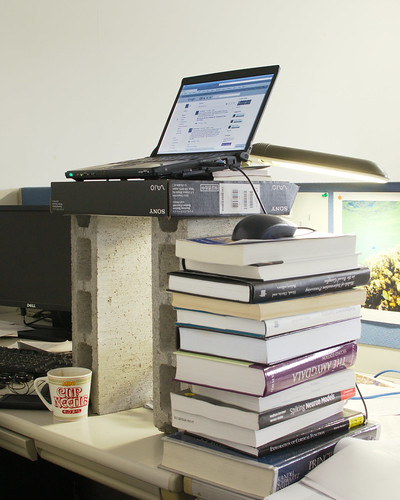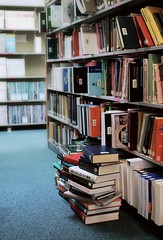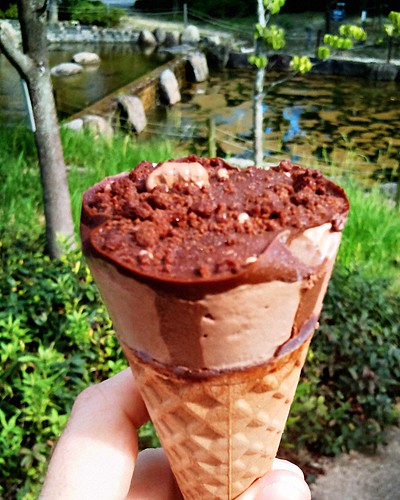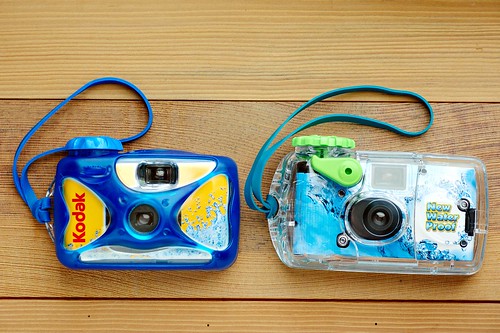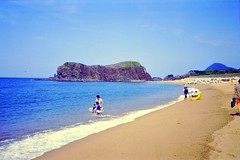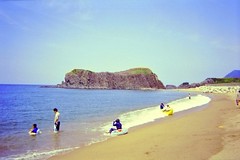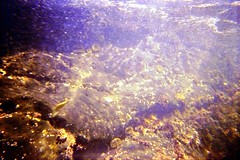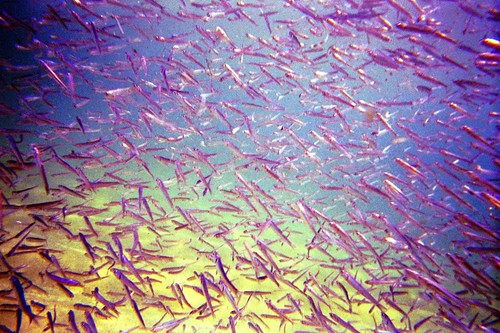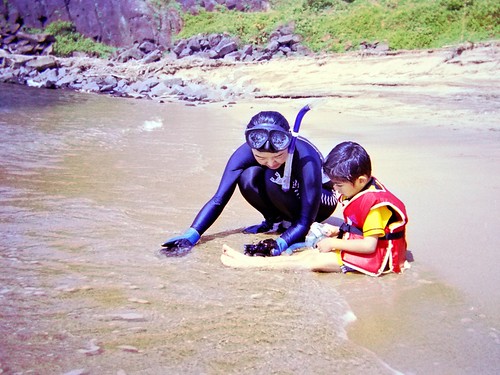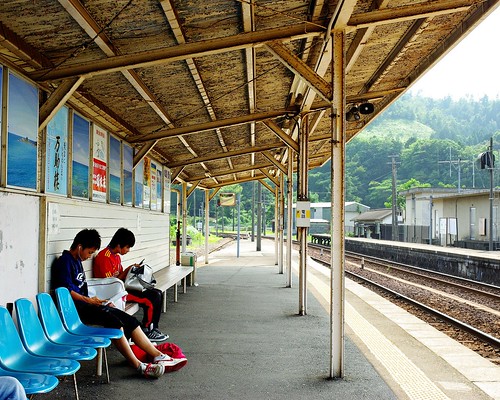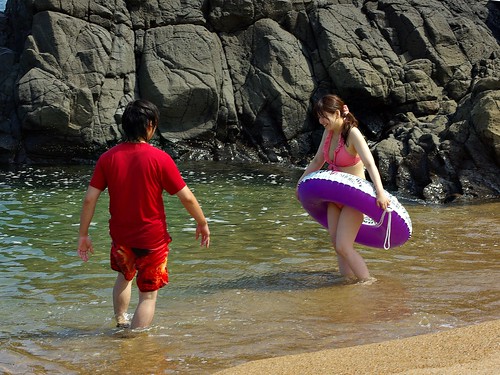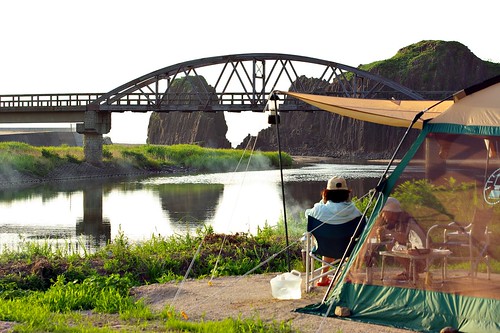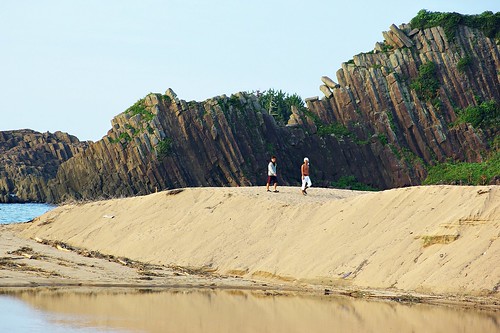In late July we went on an overnight trip to Taiza on the Tango peninsula on the north coast of Kyoto. There's some nice beaches there, so we brought two single-use underwater film cameras; one from Kodak and one from Fuji. Which one is the better choice?
Kodak to the left, Fuji to the right. Much the same design gestalt but the details differ.
The basic design is very similar: a single-use film camera preloaded with color negative film. A fixed-focus lens with a moderate aperture set at hyperfocal distance. A shutter, a film winding knob and an approximate viewfinder. All packed into a see-through underwater housing with a rubber-band strap.
There are differences of course. The Kodak uses 400ASA film while the Fuji uses 800ASA, and they naturally use their own film brands. A one stop difference in sensitivity shouldn't be very noticeable, but different film stock can make a real difference in overall color, grain and contrast. The lenses are different, but they're the same type of simple fixed-focus plastic lenses so the results are similar.
The shots below have been processed in much the same way: developed in the same lab at the same time, then scanned and processed by me, using the same scanner and the same semi-automatic tools I have to the best of my ability. Negative color film is (in)famous for being variable — there is no single "correct" result the way you have with slide film or digital — but each film does have its own characteristics.
The beach and cliff at Taiza. To the left Kodak, to the right Fuji. Click through for larger versions. Largest size for Kodak is
here and for Fuji
here.
Fuji's colors feel better to me, with less saturation, and I had to work at them less to get the images to this point. Also, the Kodak images were noticeably darker. You can clearly see bands along the top of the Kodak image; it's artefacts from my scanner (it needs a cleaning) that show up from having to brighten the image quite a lot. The Kodak uses a slower film and I suspect it also uses a smaller aperture. In combination that would be enough to make a real difference in brightness.
Center sharpness is about the same — not great, but what do you expect? Corner sharpness is much worse for the Fuji though; that would partly be explained by the difference in aperture above, as a smaller aperture gives you less corner issues.
Image quality… These are fixed-focus, fixed-shutter plastic cameras, not high-precision engineering marvels. You are not going to get precisely exposed, well-focused, high-resolution images from these. This is not the tool of choice for a cover of National Geographic. What you can hope for is a colorful A6 print that shows people what you saw, with decent detail in the center and not to badly blurred out toward the edges.
Both cameras deliver. Grain is not an issue; it is plenty finer than the resolution of each camera so you can filter it out if you want, safe in the knowledge that you're not destroying any fine detail. I happen to rather like a bit of grain so I leave it in. Overall, the Kodak seems to favour stronger blues and perhaps stronger colors in general, while Fuji tends toward warmer tones. I prefer the Fuji tones myself.
Underwater shot, again with Kodak to the left and Fuji to the right. In this case the color rendering works in Kodaks favour.
The Kodak has the better lens. The Fuji may have as good or better detail in the center, but deteriorates faster toward the edges, and has more chromatic aberration. On the other hand, Kodak ended up with significantly darker images, and the brightening during scanning made for grainier, noisier images that took more effort to clean up.
The Fuji handles better than the Kodak. It has a large, responsive, easy to use lever for a shutter, while the Kodak has a small, stiff push button that doesn't really tell you when the shot is coming. The winding mechanism is solid and dependable on the Fuji, whereas the Kodak winder is creaky, shaky and feels like it could break at any moment. I missed a few shots with the Kodak since I was never completely sure whether I'd wound fully to the next frame or not. The Kodak is smaller, though, and a bit easier to hold in your hand underwater.
Small fry with the Fuji. There may not be any coral here, but there was a lot of marine life. Here we first thought a patch of dark seaweed had drifted into shore, but it turned out to be a dense school of small fish. Also saw some larger fish, including Fugu, but they were too fast for me and my plastic camera. I have a lot of shots of absolutely nothing to show for my efforts…
Overall, I think I prefer the Fuji, despite the better optics of the Kodak. The images were easier to scan and process, I prefer the colors and the camera handles far better, especially underwater. I was more successful getting the shots I wanted, and most of the shots I've kept come from the Fuji.
A parent and child explores the shore wildlife together. There's lots of fascinating fish, crustaceans and bugs around, and little to no dangerous wildlife so it's probably a safer place for children to poke around than Okinawa. Fuji camera.
Taiza
Miyazu station. A faint breeze, chirping cikadas. Slow, lazy, relaxing.
The Tango peninsula is really quite close to Kyoto and Osaka, but the trip through the mountains is slow. You take a JR-line train northwards, then change to a small local railway (in excellent comfort, it has to be said) in Toyoka that takes you through the mountains to the Japan sea coast. It's just a short distance on the map, but it feels like an entirely different world.
The overnight trip was fun, but the mood was dampened by a swimming accident. Many groups come here camping at the beach, with parties and barbecue right on the sand. A member of one group went missing, and the entire beach was cleared for a search and rescue. They only found him several hours later and the outcome was not a happy one.
A young couple play at the beach.
Y'r hmble correspondent indulging in his sea explorer fantasy. Notice my clever use of the mask to hide my bald spot. Picture by Ritsuko.
It is a pleasant place to spend by the sea. It's not Okinawa of course so there's no coral and far less spectacular wildlife. But both air and sea temperatures are moderate and the sandy beaches are as beautiful, with no dangerous reptiles to worry about. While the wildlife is not as showy as in the south it is just as interesting.
Many people come here camping. It's a slow, relaxing place to stay, and there's both onsen and restaurants right down the road if you tire of the rustic lifestyle.
Next time we'll go in winter. The Japan sea coast is spectacular when covered in snow, and it's the high season for crab fishing so inns and restaurants offer excellent crab. We could go for a walk in the snow, thaw out in the onsen overlooking the sea, then have a luxurious crab dinner. We'll see.
Dunes and cliffs at sunset.


